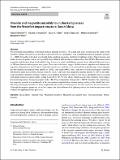| dc.contributor.author | Dellefant, Fabian | |
| dc.contributor.author | Trepmann, Claudia A. | |
| dc.contributor.author | Gilder, Stuart A. | |
| dc.contributor.author | Sleptsova, Iuliia V. | |
| dc.contributor.author | Kaliwoda, Melanie | |
| dc.contributor.author | Weiss, Benjamin P. | |
| dc.date.accessioned | 2022-09-12T13:23:51Z | |
| dc.date.available | 2022-09-12T13:23:51Z | |
| dc.date.issued | 2022-09-05 | |
| dc.identifier.uri | https://hdl.handle.net/1721.1/145354 | |
| dc.description.abstract | Abstract
We investigated microfabrics of shocked Archean gneisses from two, 10 m-deep drill cores located near the center of the Vredefort impact structure in an area that is characterized by a prominent, long-wavelength negative magnetic anomaly (< − 3000 nT) together with short-wavelength, high-amplitude anomalies attributed to lightning strikes. Planar fractures and feather features in quartz, which can be partially recrystallized, indicate shock conditions less than 20 GPa. Micrometer-sized magnetite and ilmenite along shock-related shear fractures in quartz and feldspar emanate from adjacent deformed coarse (> 100 µm) ilmenite and magnetite host grains. These fine-scaled veins suggest mobilization of magnetite and ilmenite during shear deformation of host Fe-phases and adjacent silicates, probably associated with frictional heating. Coarse ilmenite has fine-lamellar mechanical twins parallel to {10
$$\overline{1}$$
1
¯
1} and single (0001) twins, indicative of dislocation-glide-controlled deformation under non-isostatic stresses related to shock. A few µm-wide magnetite lamellae parallel to {10
$$\overline{1}$$
1
¯
1} and spheroidal magnetite (diameter ≈10 µm) within coarse ilmenite document exsolution after shock. Dauphiné twins associated with planar features in quartz imply cooling from 650 to 725 °C after shock, which accords with estimates of pre-impact basement temperatures from petrographic studies. The Curie temperature of magnetite is 580 °C; therefore, the central negative magnetic anomaly was produced as a thermoremanent magnetization acquired during cooling of the initially hot crust. The long-wavelength anomaly was likely amplified by the newly created magnetite that also acquired a thermal remanence. Although the magnetic properties of surface samples are often influenced by lightning strikes, we found no microstructural evidence for lightning-related processes. | en_US |
| dc.publisher | Springer Berlin Heidelberg | en_US |
| dc.relation.isversionof | https://doi.org/10.1007/s00410-022-01950-5 | en_US |
| dc.rights | Creative Commons Attribution | en_US |
| dc.rights.uri | https://creativecommons.org/licenses/by/4.0/ | en_US |
| dc.source | Springer Berlin Heidelberg | en_US |
| dc.title | Ilmenite and magnetite microfabrics in shocked gneisses from the Vredefort impact structure, South Africa | en_US |
| dc.type | Article | en_US |
| dc.identifier.citation | Contributions to Mineralogy and Petrology. 2022 Sep 05;177(9):88 | en_US |
| dc.contributor.department | Massachusetts Institute of Technology. Department of Earth, Atmospheric, and Planetary Sciences | |
| dc.identifier.mitlicense | PUBLISHER_CC | |
| dc.eprint.version | Final published version | en_US |
| dc.type.uri | http://purl.org/eprint/type/JournalArticle | en_US |
| eprint.status | http://purl.org/eprint/status/PeerReviewed | en_US |
| dc.date.updated | 2022-09-11T03:11:54Z | |
| dc.language.rfc3066 | en | |
| dc.rights.holder | The Author(s) | |
| dspace.embargo.terms | N | |
| dspace.date.submission | 2022-09-11T03:11:54Z | |
| mit.license | PUBLISHER_CC | |
| mit.metadata.status | Authority Work and Publication Information Needed | en_US |
